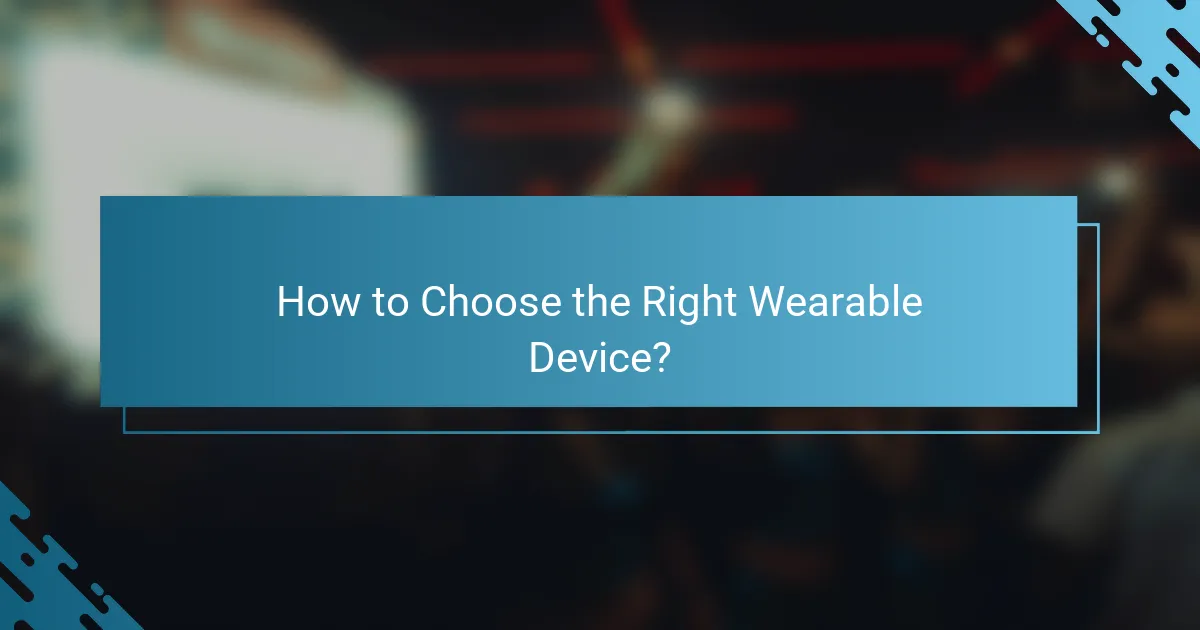Wearable devices have revolutionized health tracking by seamlessly integrating advanced technology with user-friendly features. These gadgets, such as smartwatches and fitness trackers, monitor vital health metrics like heart rate, activity levels, and sleep patterns, offering valuable insights into personal wellness. With a focus on functionality, users should consider essential features like GPS, water resistance, and battery life when choosing the right device for their needs.
![]()
What Are the Best Wearable Devices for Tracking Health?
The best wearable devices for tracking health combine advanced technology with user-friendly features to monitor various health metrics. Key options include smartwatches and fitness trackers that provide insights into heart rate, activity levels, sleep patterns, and more.
Apple Watch Series 8
The Apple Watch Series 8 is a leading smartwatch known for its comprehensive health tracking capabilities. It features advanced sensors that monitor heart rate, blood oxygen levels, and body temperature, making it suitable for a wide range of health metrics.
With its seamless integration with iOS devices, users can easily access health data and receive notifications. The watch also supports various fitness apps, allowing for personalized workout tracking and goal setting.
Fitbit Charge 5
The Fitbit Charge 5 is a popular fitness tracker that focuses on health and wellness. It offers features like heart rate monitoring, stress management tools, and sleep tracking, providing a holistic view of the user’s health.
This device stands out with its Daily Readiness Score, which helps users determine if they are ready for a workout or need recovery time. Its long battery life, often lasting up to a week, makes it convenient for continuous monitoring.
Garmin Venu 2
The Garmin Venu 2 is designed for fitness enthusiasts, offering robust tracking features for various sports and activities. It includes GPS functionality, heart rate monitoring, and advanced sleep tracking, catering to both casual and serious athletes.
One of its unique features is the Body Battery, which measures energy levels throughout the day, helping users optimize their activity and rest periods. The vibrant display and customizable watch faces enhance user experience.
Samsung Galaxy Watch 5
The Samsung Galaxy Watch 5 combines smartwatch functionality with health tracking features. It includes heart rate monitoring, blood oxygen tracking, and advanced sleep analysis, making it a versatile choice for health-conscious users.
This device also offers a range of fitness tracking modes and integrates well with Samsung Health, providing a comprehensive overview of health metrics. Its durable design and long battery life add to its appeal.
Whoop Strap 3.0
The Whoop Strap 3.0 is a unique fitness tracker that focuses on recovery and performance optimization. It tracks heart rate variability, sleep quality, and strain levels, providing insights tailored for athletes and fitness enthusiasts.
Unlike traditional wearables, Whoop operates on a subscription model, offering personalized coaching based on collected data. This approach helps users understand their bodies better and make informed decisions about training and recovery.

How Do Wearable Devices Track Metrics?
Wearable devices track metrics through a combination of sensors and algorithms that monitor physiological and physical activities. These devices collect data on various health indicators, providing users with insights into their fitness and wellness.
Heart Rate Monitoring
Heart rate monitoring is typically achieved using optical sensors that detect blood flow through the skin. These sensors use light to measure the changes in blood volume, allowing the device to calculate beats per minute (BPM). Most fitness trackers provide real-time heart rate data, which can help users optimize their workouts and manage stress levels.
When selecting a wearable for heart rate monitoring, consider accuracy and comfort. Devices that fit snugly on the wrist tend to provide more reliable readings. Look for features like continuous heart rate tracking and alerts for abnormal heart rates.
Step Counting
Step counting is accomplished through accelerometers that detect movement patterns. These sensors track the acceleration of the device, translating it into steps taken throughout the day. Many wearables also offer goal-setting features, encouraging users to reach daily step targets.
To maximize the effectiveness of step counting, wear the device consistently and ensure it is calibrated correctly. Some devices allow users to adjust their stride length for more accurate step counts, especially for individuals with varying walking styles.
Sleep Tracking
Sleep tracking utilizes a combination of motion sensors and heart rate monitoring to analyze sleep patterns. By detecting movements and changes in heart rate, wearables can determine sleep stages, including light, deep, and REM sleep. This data helps users understand their sleep quality and duration.
For effective sleep tracking, wear the device snugly on your wrist overnight. Look for wearables that provide insights into sleep trends over time, which can help identify factors affecting sleep quality, such as stress or lifestyle changes.
Calorie Burn Estimation
Calorie burn estimation is calculated using algorithms that factor in heart rate, activity level, and personal data like age, weight, and gender. Wearable devices provide estimates of calories burned during various activities, helping users manage their energy balance.
To improve the accuracy of calorie burn estimates, ensure that your personal information is correctly entered into the device. Some wearables offer exercise-specific modes that enhance calorie calculations based on the type of activity performed, such as running or cycling.

What Features Should You Look for in Wearable Devices?
When selecting a wearable device, prioritize features that enhance functionality and usability. Key aspects include GPS functionality, water resistance, battery life, and compatibility with apps, all of which significantly impact your experience and the device’s effectiveness.
GPS Functionality
GPS functionality is essential for tracking outdoor activities such as running, cycling, or hiking. A device with built-in GPS allows for accurate distance and pace measurements without needing to connect to a smartphone.
Look for devices that offer real-time tracking and route mapping. Some wearables can also store GPS data for later analysis, which is beneficial for serious athletes aiming to improve their performance.
Water Resistance
Water resistance is crucial for wearables, especially if you plan to use them while swimming or in wet conditions. Devices are typically rated with an IP (Ingress Protection) rating, indicating their level of water and dust resistance.
For swimming, aim for a device with at least a 5 ATM rating, which means it can withstand pressures equivalent to a depth of 50 meters. This ensures durability and functionality during aquatic activities.
Battery Life
Battery life varies significantly among wearable devices, with some lasting only a day and others up to a week or more. Consider how often you are willing to recharge your device based on your usage patterns.
Devices with extensive features like continuous heart rate monitoring or GPS tracking typically consume more power. Look for wearables that offer power-saving modes to extend battery life during prolonged use.
Compatibility with Apps
Compatibility with apps enhances the functionality of wearable devices by allowing data synchronization and access to additional features. Ensure the device supports popular health and fitness apps that align with your goals.
Check for integration with platforms like Apple Health, Google Fit, or specific training apps. This connectivity can provide a more comprehensive view of your health metrics and facilitate better tracking of your progress.

What Are the Benefits of Using Wearable Devices?
Wearable devices offer numerous benefits, primarily enhancing health awareness, motivating fitness goals, and providing real-time feedback. These advantages can lead to improved overall wellness and a more active lifestyle.
Improved Health Awareness
Wearable devices help users track various health metrics, such as heart rate, sleep patterns, and physical activity levels. This constant monitoring fosters a greater understanding of personal health, allowing individuals to identify trends and make informed decisions about their lifestyle.
For example, many devices can alert users to irregular heart rates or insufficient sleep, prompting them to seek medical advice or adjust their habits. By regularly reviewing these metrics, users can develop a clearer picture of their health status over time.
Motivation for Fitness Goals
Wearable devices can significantly boost motivation by setting achievable fitness goals and tracking progress. Many devices allow users to set daily step counts, workout durations, or calorie burn targets, creating a sense of accountability.
Additionally, features like gamification—such as earning badges or competing with friends—can enhance engagement. Users often find that visualizing their progress encourages them to stay committed to their fitness journey.
Real-Time Feedback
Real-time feedback from wearable devices enables users to make immediate adjustments to their activities. For instance, during workouts, devices can provide instant data on heart rate and calories burned, helping users optimize their performance.
This immediate information allows individuals to push themselves safely or scale back when necessary, reducing the risk of injury. By leveraging real-time insights, users can enhance their training effectiveness and overall fitness outcomes.

How to Choose the Right Wearable Device?
Choosing the right wearable device involves assessing your specific needs and preferences. Focus on your fitness goals, budget, and the features that matter most to you.
Assess Your Fitness Goals
Identifying your fitness goals is crucial in selecting a wearable device. Whether you aim to track daily steps, monitor heart rate, or analyze sleep patterns, different devices cater to various objectives.
For example, if weight loss is your goal, a device with calorie tracking and activity reminders may be beneficial. Alternatively, if you are training for a marathon, consider a smartwatch that offers GPS tracking and advanced metrics.
Consider Your Budget
Your budget will significantly influence your choice of wearable device. Prices can range from affordable fitness bands to high-end smartwatches, typically starting around $30 and going up to several hundred dollars.
Evaluate what features are essential for you and look for devices that fit within your financial range. Remember, more expensive devices often come with additional functionalities, but there are many budget-friendly options that still offer solid performance.